Topics
Tips for Health Cooking
Tip 1: How to Reduce Fat
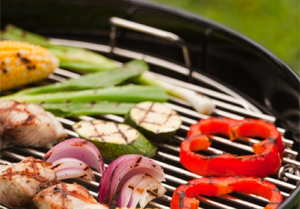 The main rule of thumb for healthy cooking is to reduce the use of methods that require excessive fat and calories, such as deep frying. Consider, for instance, that each tablespoon of oil you use when frying adds approximately 14 grams of fat and 125 calories. Since a healthy adult eating a 2,000-calorie diet should have no more than about 60 grams of fat a day, four tablespoons of oil would supply all the fat needed in a day.
The main rule of thumb for healthy cooking is to reduce the use of methods that require excessive fat and calories, such as deep frying. Consider, for instance, that each tablespoon of oil you use when frying adds approximately 14 grams of fat and 125 calories. Since a healthy adult eating a 2,000-calorie diet should have no more than about 60 grams of fat a day, four tablespoons of oil would supply all the fat needed in a day.
By using healthy cooking techniques that intensify the taste of foods, you can cut back the fat and calories. Try grilling, broiling, roasting, or baking—they don’t add extra fat. Below are suggestions on how reduce fat when selecting and preparing foods. Give one or two of these tips a try when preparing your next meal.
Sauces
- Make soups, stocks, stews, and braises the day before and refrigerate overnight allowing the fat to rise to the top for easy removal. The extra time also helps the flavors to develop.
- After browning or roasting meats or poultry, drain the extra fat before adding other ingredients to make a sauce.
- Try serving vegetable salsas and fruit chutneys with meat or poultry in place of heavy gravies or sauces.
- Cooked legumes can also make hearty sauces without all the fat.
- Use pureed vegetables, starchy ingredients, like rice, beans, or pure starch, like arrowroot as a replacement for roux.
- Evaporated skim milk is a good way to simulate the effect of cream in many applications because of its similar color, flavor and viscosity.
Meats

- Use sensible portions of lean cuts of beef and pork, as well as low-fat dairy to keep saturated fats in check.
- Marinating meat, poultry or fish before grilling or broiling is a simple step to bring out the maximum flavor potential. Foods like soy sauce, salad dressings, and seasoning packets can be high in sodium. Choose low-sodium marinades.
- Consider fish. Most fish are lower in saturated fat than meat. Some fish, such as mackerel, sardines, and salmon, contain omega-3 fatty acids that are being studied to determine if they offer protection against heart disease.
Desserts
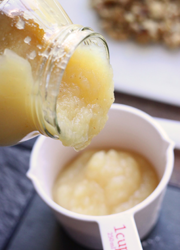
- Reduce the fat in home baked goodies by substituting applesauce, pureed prunes, mashed bananas or yogurt for up to half of the butter or shortening.
- Use two egg whites instead of one whole egg to significantly reduce the fat and cholesterol content of some baked goods.
- Cream cheese in a cheesecake can be replaced by a combination of reduced-fat cream cheese, nonfat yogurt drained of its whey, and pureed low-fat cottage and ricotta cheeses.
Oils & Fat Substitutions
You can replace more fattening ingredients with healthier ones without sacrificing the taste and overall satisfaction. Even if you do not feel completely comfortable substituting all of an ingredient, try substituting half of the higher fat ingredient for its lower fat counterpart.
Instead of |
Try a healthier substitution |
Sour cream |
Plain low-fat yogurt |
Cream cheese |
Low-fat cream cheese |
Whole eggs |
Egg substitutes or egg whites |
Regular cheese |
Reduced-fat cheese |
Vegetable oil |
Applesauce |
Ricotta cheese |
Low-fat cottage cheese |
Heavy cream |
Evaporated skim milk |
Also consider trying alternatives and healthier oils.
- Use veggie spray or non-stick pans for grilling or stir-frying.
- Use cooking oils, such as olive or canola oil, rather than animal fats like butter and lard.
Tip 2: How to Reduce Sodium
How do you create mouth-watering, satisfying food while limiting the amount of sodium used? Luckily, some experts from The Culinary Institute of American and Harvard School of Public Health got together and mulled over this very question. From this extensive meeting of the minds and palates came “Tasting Success with Cutting Salt: 25 Science-Based Strategies & Culinary Insights.” We’ve selected a sampling of these strategies that may help you curb your sodium levels without compromising taste.
Focus on Fruits and Vegetables
Most of the sodium Americans eat is found in processed foods. Aim to eat highly processed foods less often and in smaller portions. Fresh foods are generally lower in sodium. Eat plenty of vegetables and fruits— fresh or frozen. Try to eat vegetables and fruits at every meal.
- Downsize portions: You’ll scale back the sodium and the calories.
- Get fresh: Choose unprocessed or minimally processed foods.
- Produce first: Fill half the plate with fruits and vegetables.
- Our bodies need more potassium than sodium; however, our actual diets are often the opposite, which can contribute to high blood pressure.
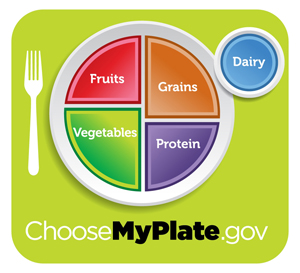 Fruits and vegetables are naturally low in sodium, and many fruits and vegetables are good sources of potassium.
Fruits and vegetables are naturally low in sodium, and many fruits and vegetables are good sources of potassium. - Filling plates with them will boost potassium and help to shift sodium-potassium balance in the favor of good health.
Potassium is found in vegetables and fruits, such as potatoes, beet, greens, tomato juice and sauce, sweet potatoes, beans (white, lima, kidney), and bananas. Other sources of potassium include yogurt, clams, halibut, orange juice, and milk. - Umami*: Research reveals that adding ingredients with umami properties heightens the perception of saltiness in a dish, making umami an area of intense culinary interest for culinary professionals interested in sodium reduction.
- Cooked chicken, fish, beef and soybeans are naturally high in umami, as are mushrooms, tomatoes, seaweed, carrots and Chinese cabbage.
- Incorporating these foods into meals can add a delicious depth of flavor with adding salt.
- Some foods are high in umami are also high in sodium, including soy sauce, fish sauce, aged cheese, miso and anchovy paste. Try to avoid or limit these foods.
*Umami is a pleasant savory taste imparted by glutamate, a type of amino acid, and ribonucleotids, which occur naturally in many foods including meat, fish, vegetables and dairy products.
Watch Out for Hidden Sodium
Read the Nutrition Facts label and the list of ingredients to find packaged and canned foods lower in sodium. Look for foods labeled “low sodium,” “reduced sodium,” or “no salt added.”
- Rinse, wash and dilute: you can easily cut excess sodium in processed foods with no loss of flavor.
- Draining and rinsing canned foods can dramatically cut their sodium levels—in the case of canned beans, cooks can cut 40% of the sodium with this trick. When making soup, dilute reduced sodium chicken broth with water or wine instead of using it full strength, and float in some additional vegetables and herbs.
- “Fresh” and “natural” meats and poultry may be injected with salt solutions as part of their processing, and manufacturers are not required to list the sodium content on the label. The best way to find out if a brand has been treated with a salt solution is to ask the grocer or butcher.
- Embrace healthy fats and oils: A savory strategy to lower sodium levels
- Unfortunately, many product developers cut both good and bad fats out of formulations during the no-fat craze of the 90’s, and in order to maintain consumer acceptance of their products, they increased levels of sugar and sodium. Be weary of fat-free salad dressings and similar products, they may contain hidden sodium.
Spice it Up with Simple Flavors
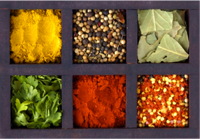 Simple flavor additions can enhance food with less salt. Make an effort to skip adding salt when cooking and work to keep salt off the kitchen counter and the dinner table.
Simple flavor additions can enhance food with less salt. Make an effort to skip adding salt when cooking and work to keep salt off the kitchen counter and the dinner table.
Use spices, herbs, garlic, vinegar, or lemon juice to season foods or use no-salt seasoning mixes. Try black or red pepper, basil, curry, ginger, or rosemary.
- TASTE BEFORE YOU SALT!
- Avoid “double salting” foods when cooking, and look for ways to pair salted flavors with unsalted or under-salted foods, especially fresh produce. If you add a ham bone to a soup, lighten up on the sodium for the rest of the soup. In a sandwich, try adding sliced cucumber instead of pickles. And an adequately seasoned crust or condiment may lessen the need for salting the rest of the dish.
- Add salt late in the cooking process as foods release their flavors (and salt) during the cooking process, and “palate fatique” on the part of the cook can cause over-salting if this is undertaken too early
- Sear, sauté, and roast: The right cooking method can help spare the salt.
- Searing and sautéing foods in a pan builds flavor while roasting brings out the natural sweetness of many vegetables and the savoriness of fish and chicken.
Tip 3: How to Increase Fiber
Fiber, also known as roughage or bulk, is the part of plant foods that cannot be digested by the body. This means it does not get absorbed into the bloodstream; thus, does not give us calories. Fiber that occurs naturally in foods is called dietary fiber. Since it is only found in plant foods, dietary fiber can be consumed by eating a vibrant array of whole fruits and vegetables, whole grains, nuts, seeds, and legumes. Increasing fiber-rich foods into dishes is as easy as follows:
Eat a Variety of High-Fiber Fruits and Vegetables
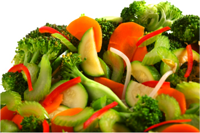 Use high-fiber vegetables like carrots and broccoli as side dishes or additions to salads and soups.
Use high-fiber vegetables like carrots and broccoli as side dishes or additions to salads and soups. - Cook vegetables briefly because the longer they cook, the more fiber they lose. Try steaming them until they are crisp yet tender to retain most of the fiber content.
- Use whole fruits.
- Eat the skin. Whether it is apples, pears, or potatoes, most of the fiber is in the skin or peel.
Add Whole Grains, Legumes & Nuts
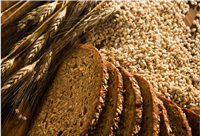 Replace white rice, bread, and pasta with brown rice, whole grain products, whole-wheat pasta, and exotic grains, like bulgur or amaranth, once in awhile.
Replace white rice, bread, and pasta with brown rice, whole grain products, whole-wheat pasta, and exotic grains, like bulgur or amaranth, once in awhile. - Read the Nutrition Facts labels for cereals. Choose breads and crackers that have at least three grams of fiber per serving.
- Use oatmeal, whole-wheat flour, brown rice or wheat germ in baked goods.
- Use whole grains in mixed dishes, such as barley in vegetable soup or stews and bulgur in casseroles or stir-fries.
- Add legumes (beans, lentils, and peas), such as chickpeas or kidney beans, to salads and soups. They are great tasting, cheap source of fiber, protein, and other important nutrients.
- Go nuts by substituting almonds or other nuts for croutons in salads.